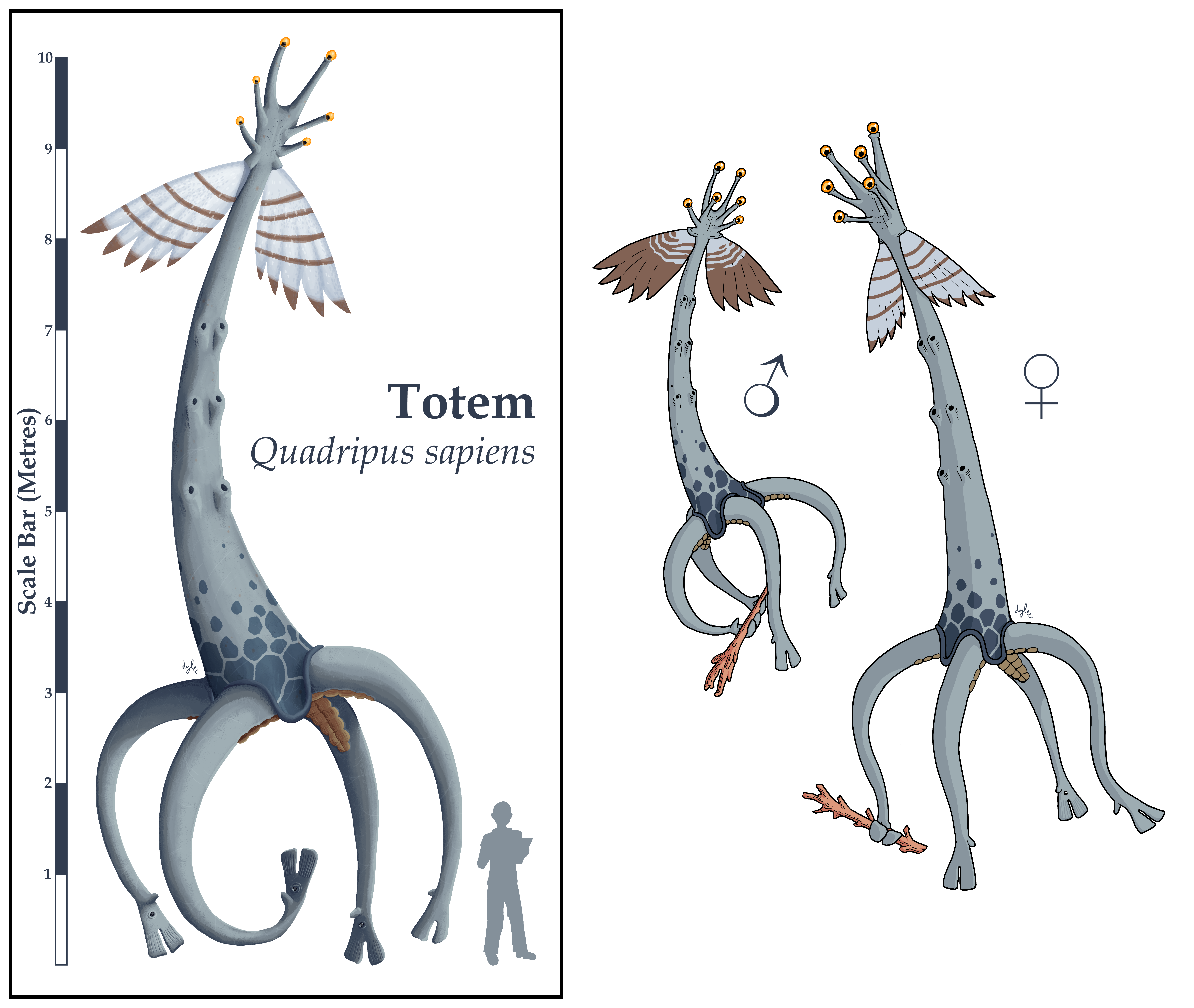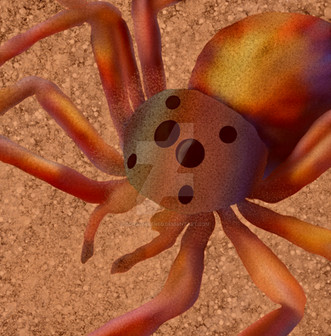HOME | DD
 Tree-Sparrow — Cerberus: a Drying World
Tree-Sparrow — Cerberus: a Drying World

#alien #astrobiology #cerberus #evolution #exobiology #exoplanet #life #planet #scifi #space #speculative #xenobiology #lasobi #extraterrestrial #sciencefiction
Published: 2021-12-30 04:12:22 +0000 UTC; Views: 5302; Favourites: 47; Downloads: 5
Redirect to original
Description
This is a graphical representation of the progressive loss of water seen on the exoplanet Cerberus over the course of the last ~400 Ma ("Ma" = mega annum, i.e., million years). In this time, Cerberus went from a flourishing, warm, ocean world to a struggling, cold, desert exoplanet. In the present, the little water remaining on this exoplanet is mostly trapped within vast polar ice caps, and life is restricted to three habitable bands ("Corona Habitabilia"), at 0°, 60°N, and 60°S latitude.The rate of water loss on Cerberus is proportional to the flare intensity of its two parent stars, Salibe and Cheansa, with recent periods in Cerberus' history being subjected to low flare intensities and thus low rates of water loss. Note that time skips forward at varying rates in the gif in proportion to these changing rates of water loss.
White lines represent mountain chains. Brown lines represent rift valleys. Blue represents Cerberus' seas and lakes, and beige represents arid land. Light grey represents salt seas, and in the present day, areas of white represent ice caps. Finally, red areas represents vegetated regions of land.
Below is a simple timeline of some important events in Cerberus' geologic history (this timeline is a work in progress, and I will likely produce a nice graphic to represent it in future!).
-----
0 Ma - Present
~3 Ma - Disparus sapiens (Lasobs) evolve in the tundra around Attenborough Lacus
16 Ma onwards - As atmospheric carbon is continually trapped in carbonate rocks faster than it can be replaced by volcanic processes, the greenhouse effect of Cerberus' atmosphere weakens. Resultantly, temperatures decrease until the first permanent ice caps form on Cerberus' poles. From this point onwards, these ice caps only grow as Cerberus' average global temperatures drop. The formation of ice exacerbates the rate of loss of liquid water on Cerberus' surface.
0 to 16 Ma - Cryochronian Period
62 Ma - The Impius and Hydra Mare separate due to their shrinking coastlines. This separates populations of marine polyostians (the dominant maxivitans in these seas), resulting in today's divergent communities.
76 Ma - The second flood basalt eruption of the Pompeii Mare supervolcanic province. This results in the third major mass extinction event in the last 400 million years.
16 to 76 Ma - Sessilian Period
130 Ma - The earliest evidence of terrestrial polyostians in the Southern Habitable Band.
140 Ma - The earliest evidence of megafaunal terrestrial hexacoelomates.
149 Ma - A brief interlude of mantle activity on Cerberus causes the Purpureus Valles rift valley to begin spreading apart. Resulting volcanic emissions cause an atmospheric imbalance and a short ice age. This causes the second major mass extinction event in the last 400 million years of Cerberus' history.
76 to 149 Ma - Neovitian Period
160 Ma - The earliest evidence of terrestrial hexacoelomates in the fossil record.
204 Ma - Salibe, Cerberus' main parent star, reaches its current low-flare-activity state, and the rate of water loss begins to slow down.
149 to 213 Ma - Various cataclysmic events throughout this time period result in high extinction rates and an overall constant low biodiversity. Polycirrates are the dominant phylum of maxivitans in all three habitable bands.
213 Ma - The first flood basalt erruption of the Pompeii Mare supervolcanic province. This results in the first major mass extinction event in the last 400 million years.
149 to 213 Ma - Cataclysmian Period
220 Ma - The earliest evidence of terrestrial non-hexacoelomate arcacoelomates in the fossil record, in the Northern Habitable Band.
226 Ma - The earliest fossil evidence of terrestrial triannulids in the Equatorial Habitable Band.
238 Ma - The earliest evidence of terrestrial polycirrates in the fossil record. Swiftly proceeding this, evidence of polycirrates on land is present throughout all of Cerberus' habitable bands, indicating an explosion in species diversity within this group.
270 Ma - The Pompeii and Geminus Maria separate due to their receding coastlines.
213 to 270 Ma - Edenian Period
282 Ma - The Vacuus Mare separates from the Geminus-Pompeii Mare.
300 Ma - The earliest fossil evidence of marine triannulids is present in the Equatorial Habitable Band.
304 Ma - The seas of the Northern and Equatorial Habitable Bands separate, birthing the land which will eventually become the northern xeric band (Arena Borealis).
305 Ma - Draco Lacus separates from the Impus-Hydra Mare due to its receding coastlines.
311 Ma - The earliest crown-group polyostians are present in the fossil record.
312 Ma - The Ater Mare and the Nix Mare separate.
317 Ma - The earliest crown-group arcacoelomates are present in the fossil record.
320 Ma - The seas of the Southern Habitable Band separate from all other seas on Cerberus, birthing the land which will eventually become the southern xeric band (Arena Australis).
270 to 320 Ma - Transitivian Period
350 Ma - The earliest evidence of terrestrial ferraphytes (fossil tubes) is present in the fossil record. These early ferraphytes would eventually evolve into the multitude of iron plants that carpet Cerberus as the dominant vegetation today.
378 Ma - Earliest evidence of terrestrial Erythrophytes (fossil spores). These "true red plants" remain present on Cerberus only as low-lying, moss-like vegetation and encrusting, lichen-like species. They are subordinate to the iron plants in ecological prominence.
382 Ma - The earliest non-volcanic landmasses begin emerging from Cerberus' primordial global ocean, as sea levels drop due to the action of Salibe and Cheansa's stellar flares.
320 to 382 Ma - Neoterran Period
468 Ma - From this point in time, the earliest evidence of complex marine maxivitans is found. These belong to the phyla Intestinopsa, Neoradiata, Haplohelminthes, Dolichozoa, Diannulida, and Polycirrata. The apparent diversity of maxivitan life at this period is indicative of an earlier presence of this kingdom on Cerberus that has yet to be discovered in the fossil record.
382 to 512 Ma - Proteroterran Period
~670 Ma - Plate tectonics on Cerberus ceases due to a lack of internal heat in Cerberus' core. This results in Cerberus' crust forming a stationary "solid lid" around the entire exoplanet. The only exchange of atmospheric gasses from this point onwards comes from active volcanism on this exoplanet's surface.
512 to 670 Ma - Immobilian Period
670 MA and priot - Little is known from this period in time due to a limited amount of human excursion on the surface of Cerberus.
670 Ma and prior - Ambulatian Supereon.
-----


























